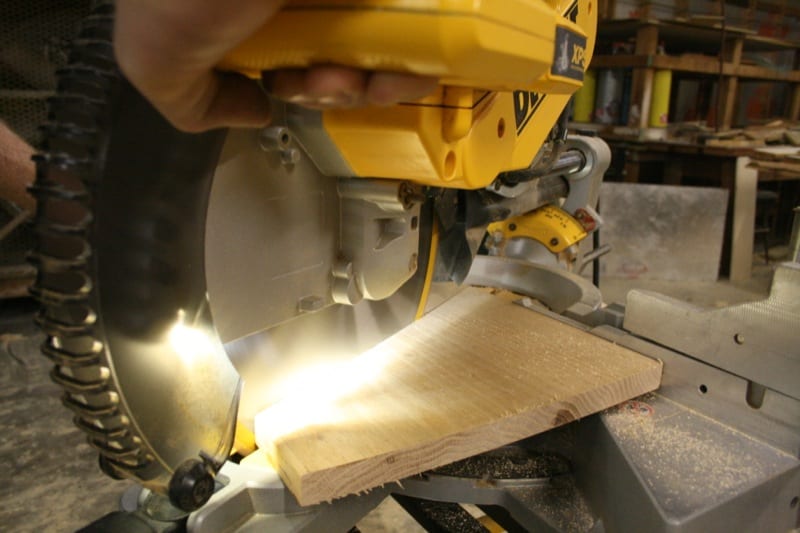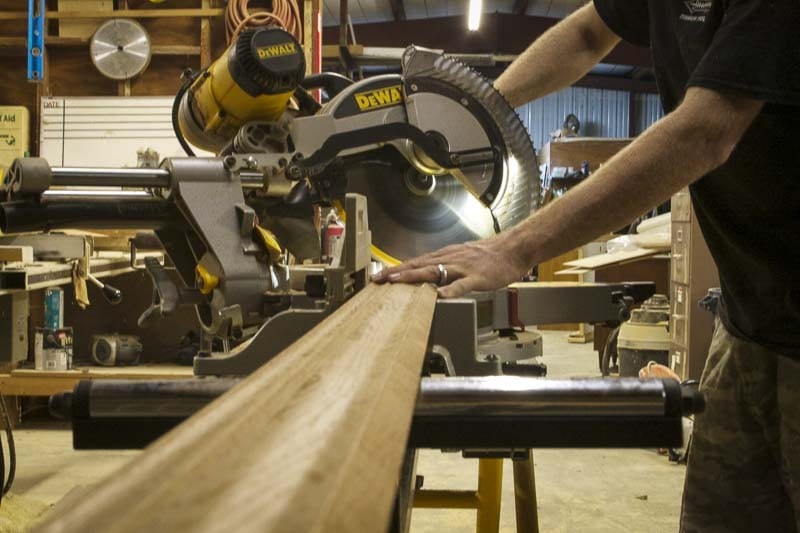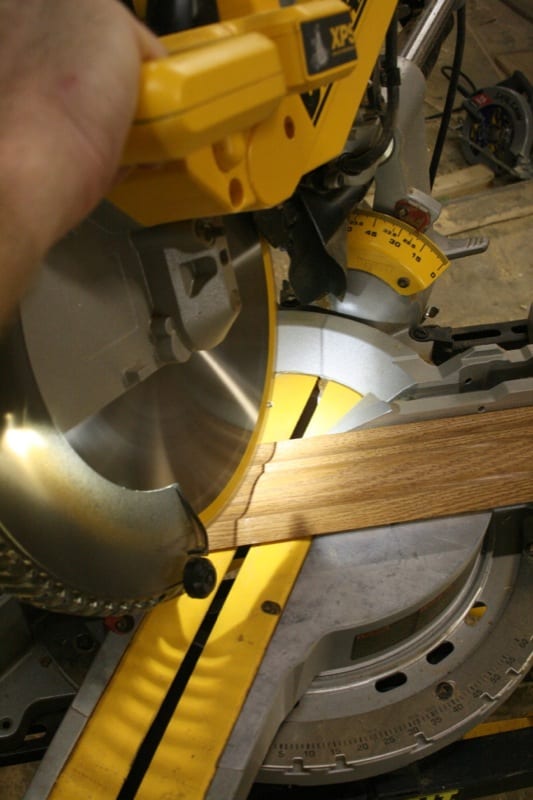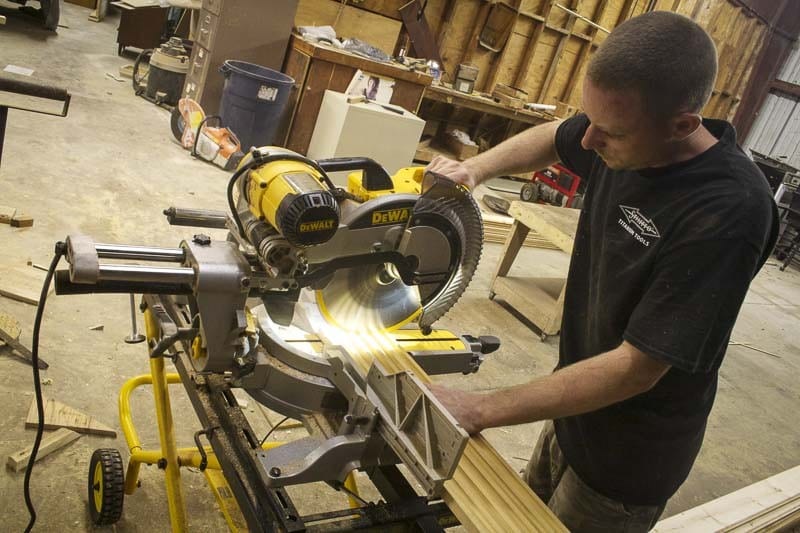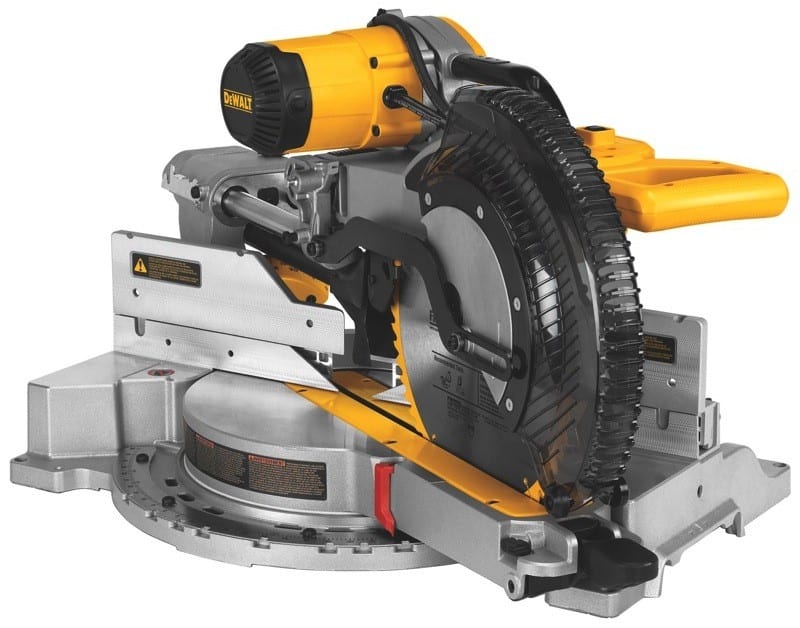At first glance, the DeWalt DWS780 miter saw looks impressive—like it means business. It also looks very similar to the well-regarded DW718 miter saw. The combination of yellow, black, and chrome are certainly defining characteristics. I first noticed the dual horizontal slide bars—for good reason. The DeWalt DWS780 didn’t just switch the last two numbers from my last saw, the DW708…it also switched the vertical slide bars back to horizontal!
DWS780 Miter Saw Power
With a 15-amp, 3,800 RPM motor, the DeWalt DWS780 miter saw had plenty of “push”. Whether cutting a small piece of crown molding or a 4×4 pressure treated post, it breezed through. I never felt like it had an insufficient amount of power to get the job done. As a matter of fact, the thought of the saw’s power never even crossed my mind while working. Generally, that’s a good sign because honestly… I have more important things to worry about on a job with tight deadlines and…assertive project managers.
DeWalt XPS Cross Cut Positioning System
The DeWalt XPS Cross Cut Positioning System makes for one of the most helpful new features DeWalt has ever added. It’s the “Why didn’t I think of that” kind of feature. Instead of using a laser, DeWalt employs a small but powerful LED light directly over the saw blade.
The light casts a shadow of the blade onto the material below. As the saw blade lowers, the shadow of the blade narrows to the exact width and location of the cut. It works on every cut, miter, or bevel, and it works with every blade. Some bevel cuts may require a slight tilt of the head to see.
And now for the best part—the shadow cutline even remains visible outside in direct sunlight. Laser guides fall apart outdoors, becoming useless. Another advantage of the XPS system over a laser guide is that it didn’t lose accuracy when it was bumped.
I found the XPS LED cut line system very useful when installing both the hardwood floors and a tongue and groove ceiling. Rough cuts that didn’t need to be accurate to within 1/16” (because they were getting covered by base, cove, or some other trim) were particularly quick. The XPS light system allowed me to simply glance, chop, and the job was done.
Increasing Cut Depth by Removing the Back Fence
Another solid aspect of the DWS780 I used a lot was the back fence. This feature gave me the ability to increase normal cut depth on 1X material to a full 16-1/8″ at 90º. I could even cross-cut a 2×12 at 45°! This extremely valuable feature reduces the “normal” burden of cutting wide materials on a chop saw.
Cutting Crown Molding with the DeWalt DWS780
I like having the 60º and 50º miter capabilities to the right and left respectively. I could also appreciate how narrow the saw became when in the 60º position. It gave me some helpful compactness when storing the saw in my rather tight work trailer.
When cutting crown molding or 1×8 base caps for my front porch columns, I used the double bevel cut options extensively. Unlike a single-bevel saw, the DWS780 lays down for a bevel cut both ways. It didn’t need to flip 16 ft. pieces of crown over. That might have dinged up new drywall. I also didn’t have to worry about transferring measurements from one side of the board to the other in order to cut the boards finish-side down.
To get truly automated, two fold-away stops for left and right bevel provide for cuts at 22.5° and 33.9°. As you can imagine, when cutting a bunch of molding this could save a lot of time. Having these stops easily accessible, and just as easily defeatable, makes for quick cuts and more options to potentially speed up your workflow.
Horizontal Dual Steel Rails
I’ve used DeWalt’s previous DW708 miter saw for the past 7 years. One of the big improvements in the DWS780, which I believe began (at least in the 12″ models) with the DW718, is the change in the dual steel rail configuration. Instead of positioning the dual steel rails vertically, the new DWS780 miter saw uses horizontal rails.
I’ve made thousands of 45º bevel cuts on 5-1/4″ baseboard (most of them as the first step in the coping process). One problem I have consistently run into was a small amount of flex in the saw when it was laid on a 45º angle. This created a slight belly in what was supposed to be a straight cut. It always made me angry that my corners weren’t perfectly tight in the middle despite being tight at both top and the bottom. As I made my cuts with the DWS780, the problem was gone. By configuring the rails in the upright position, they actually become vertical in relation to the downward pressure. This gives them strength as the saw lays down on a 45º angle.
Room for Improvement
As much as I enjoyed using the saw, I took away one small issue with it. Despite DeWalt’s claim of a “super-efficient dust collection system” that “captures over 75% of dust generated,” I found their dust collection system to be far from super-efficient. At least, that seemed the case when operating the saw without a shop-vac.
The rather long dust tube kept getting clogged easily (and therefore frequently). On more than one occasion this led to a cloud of sawdust in my face as I cut. Obviously, the speed at which the tube gets clogged depends on the moisture content of the material you are cutting. It also has to do with the moisture content in the air. I did use the saw in the heat of summer in humid Central Florida, so perhaps others will have less of an issue.
Using the DWX726 Rolling Miter Saw Stand
As great as the 12″ miter saw is by itself, I also had the opportunity to use it with its counterpart, the DeWalt DWX726 rolling miter saw stand. Like a fine wine, it makes a good pairing. Although the combination offers excellent mobility and functionality, yu get some awkward storage and transportation from job to job. A very large space is needed to accommodate the stand/saw combo, which together is quite substantial.
The unit took up more space than I liked in my work trailer. I would have preferred a quick-connect/disconnect system (such as the one that comes with the DW723 stand). The current method has you bolt the saw directly to the stand. Additional flexibility for a more versatile storage option would make this even more flexible and valuable to the professional carpenter.
Specifications
- Model: DeWalt DWS780
- Motor: 15-amp, 3800 RPM
- Max cross-cut (90°): 2×16 in
- Max cross-cut (45°): 2×12 in.
- Miter detents: 10
- Cam lock miter handle with detent override
- Dual horizontal steel rails
- Belt-drive
- Back fence design
- XPS cross-cut LED positioning system
- Weight: 56 lbs.
- Price: $599
Conclusion
All in all, the DeWalt DWS780 miter saw helped me make my deadline and deliver a final product any project manager would be happy to sign off on. Despite some very minor issues, the DeWalt DWS780 miter saw proved to be precise, powerful, and extremely versatile. Bells and whistles should be ringing and blowing, because it’s got ‘em. I thought nothing would ever replace my DW718, however, I would have to say that after using this saw for several weeks at home and on the job site, the DWS780 is worthy of carrying the torch.

